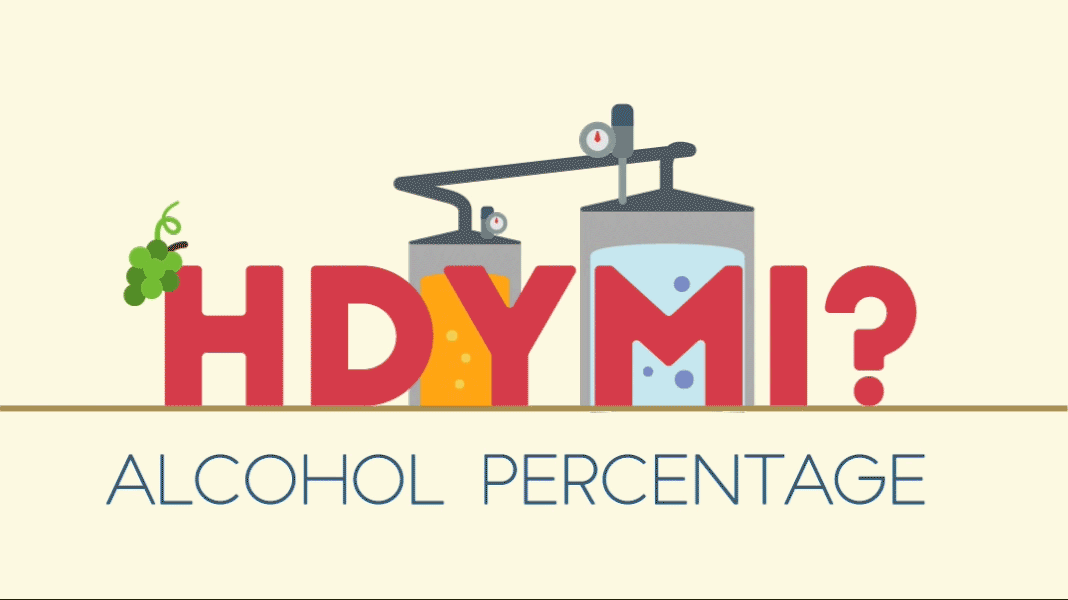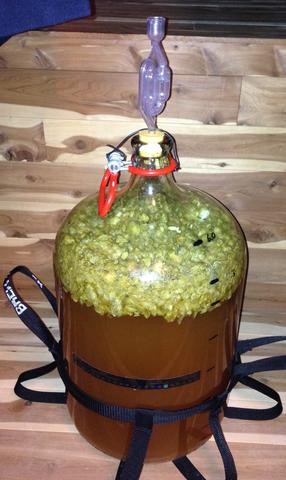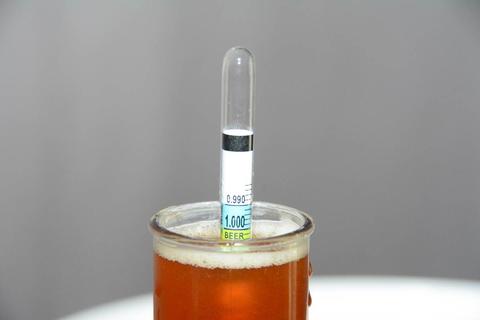How to Test the Alcohol Content of Homemade Wine Without a Hydrometer

Credit: B. Hayes/NIST
The short answer
People making their own alcoholic beverages often calculate the percentage of alcohol by volume by measuring their relative density with a hydrometer or their sugar content with a refractometer. These simple instruments cleverly detect how much sugar gets converted into alcohol during the fermentation process. Larger manufacturers may call upon laboratories that can analyze their beverages with more advanced techniques, including methods known as distillation and gas chromatography.
If you're an adult of legal drinking age, you might occasionally enjoy a glass of wine, a can of beer, or another alcoholic beverage. And if you're really into beer or wine, you may make your own.
If you've opened a bottle of beer or wine recently, you may have noticed the alcohol by volume (ABV) percentage on the label. The ABV tells you the percentage of alcohol (ethyl alcohol, or ethanol) content in an alcoholic beverage.

This brewing stage shows the dry hopping process of adding hops, green cone-shaped flowers of the hop plant, which add different flavors and aromas to beer and is commonly done in brewing for pale ales and India pale ales (IPAs).
Credit: A. Urbas/NIST
Let's suppose the ABV of a beer is 5%. That means if you poured the beer into 100 equally sized tiny cups, then five of them would contain alcohol and 95 would contain the other ingredients. Of course, you can't really split up drinks this way without very fancy chemistry equipment, but maybe this mental picture gives you a better idea of what ABV means.
A standard drink in the U.S contains about 14 grams of pure alcohol, according to the Centers for Disease Control and Prevention. Different kinds of drinks may contain the same amount of alcohol but have very different ABVs because of their serving sizes. Here's a list of common alcoholic beverages — all with the same amount of alcohol — and their ABV content:
- 12 ounces of regular beer = 5% ABV
- 5 ounces of wine = 12% ABV
- 8 ounces of malt liquor = 7% ABV
- 1.5 ounces or a "shot" of hard liquor (gin, rum, vodka, whiskey, etc.) = 40% ABV
ABV percentages can vary within a class of alcoholic beverages. For example, red wines tend to have higher ABV, such as a merlot (13%-14%) compared with white wines like pinot grigio (12%-13%).
How do manufacturers — and homebrewers — accurately determine the percentage of alcohol in the beverages they make? We'll look at the different ways of measuring the alcohol percentages in common beverages.
If you're making your alcoholic beverage in your basement or vineyard, you'll probably use one of two inexpensive methods for measuring the alcohol content in your final product.
One method involves an instrument called a hydrometer, which typically consists of a small weighted tube with a numerical scale on it. In this method, you submerge the hydrometer tube into a container with a sample of your alcoholic beverage in it. The tube will sink by an amount that depends on how dense your alcoholic liquid is.
The density of the alcoholic liquid will change during fermentation, as sugar gets converted into alcohol (and for beer, bubbles of carbon dioxide, too). Before fermentation, the liquid (containing sugars that will be converted to alcohol) is denser than alcohol, and because of this, the hydrometer floats more before fermentation. After fermentation, the sugars are converted to alcohol, and the hydrometer will sink more after fermentation.
To measure ABV, you make two measurements with the hydrometer, one before fermentation and one afterward. With these measurements, you are basically finding out how much sugar in the beverage changed into alcohol during fermentation. By subtracting the first reading from the second one, and then making a simple calculation, you can find out how much alcohol is in there.
To accurately calculate the ABV, a number of important factors need to be taken into account. Temperature can affect the density, as well as the release of carbon dioxide bubbles in the case of beer. Manufacturers of hydrometers provide formulas and charts that make it easier for homebrewers and winemakers to convert their readings into an accurate ABV result. (Creating these formulas and charts requires lots of good chemistry and physics measurements too.)

A hydrometer is a tubelike instrument brewers can use to help calculate the alcohol by volume (ABV) percentage of their beers.
Credit: Shutterstock/BDoss928
An alternative to using the hydrometer is a refractometer, another simple instrument that can be used to measure concentration of substances dissolved in a liquid. When light hits a liquid, it changes direction, a phenomenon known as refraction. Refractometers measure the degree to which the light changes direction. In an alcoholic beverage, the amount of sugar as well as alcohol greatly affects how light refracts in the liquid.
Homebrewers, whiskey makers, wine makers and even wine grape growers (vignerons) use the refractometer to measure the concentrations of sugar in the wort — the liquid extracted from the mashing process when brewing beer and whiskey. Within the instrument is a measurement scale (usually one called the Brix scale, or the similar Plato scale) that is used to indicate the concentration of sugar. Once yeast is added to the wort, it ferments, converting the sugar in the wort to alcohol. To calculate the ABV, brewers need to measure the sugar concentration of the wort before it ferments, and afterward once fermentation stops.
Other factors, such as temperature, the amount of alcohol produced, and other components extracted from ingredients such as barley in beer, will change the amount of refraction that occurs throughout the fermentation process. So, to get an accurate ABV, numerous factors must be taken into account to make a good calculation. Refractometers are commonly used to measure the starting sugar concentration before fermentation and less so afterward because it requires more extensive corrections compared with hydrometer measurements and is less precise at this point.
Larger wineries and manufacturers may call upon laboratories that have more advanced methods for measuring ABV in alcohol. Two common methods they can use are distillation and gas chromatography. Distillation refers to the process of separating alcohol from the rest of the liquid by boiling and condensation using specialty glassware.
The second method, gas chromatography, is considered the most accurate method for measuring alcohol content. It involves separating and analyzing compounds by turning the mixture into a gas. The gas then moves through a column containing a solid or thick (viscous) liquid substance known as the "stationary phase" that is able to separate components based on their physical and chemical properties. These separated components can then be detected and quantified using a detector.
Measurements are important in not only understanding how laboratories get specific percentages and numbers but also how they relate to us every day. Standards for making accurate measurements go hand in hand with the measurements themselves because they validate the results we see and enable us to trust them. So, next time you pick up a bottle of wine or a six-pack of beer, you'll know how the ABV percentage is measured and what it means.
How to Test the Alcohol Content of Homemade Wine Without a Hydrometer
Source: https://www.nist.gov/how-do-you-measure-it/how-do-you-measure-percentage-alcohol-beer-wine-and-other-beverages